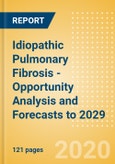Summary
Idiopathic pulmonary fibrosis (IPF) is the most common subtype of idiopathic interstitial pneumonias (IIPs), which belong to a group of rare diseases termed interstitial lung diseases (ILDs). Idiopathic pulmonary fibrosis (IPF) is a new and rapidly-establishing market, which, before 2011 was non-existent, with no approved pharmaceutical treatments for the chronic, debilitating disease, which has an abysmal prognosis. However, the last decade has seen a period of explosive growth in the IPF market following the entry of two pharmacological small molecule treatments; Roche’s Esbriet and Boehringer Ingelheim’s Ofev.
A number of growth drivers have emerged within the IPF market over the last five years, namely the acknowledgement of the lucrative IPF therapeutic market by pharmaceutical companies looking to meet the series of clinical unmet needs. These include both larger and smaller biotechnology companies alike. As such, the landscape will continue to evolve and the increasing uptake of current therapies and approval of new products will be the primary drivers of growth over the forecast period.
Key Highlights
Key Questions Answered
Scope
Reasons to Buy
The report will enable you to -
Idiopathic pulmonary fibrosis (IPF) is the most common subtype of idiopathic interstitial pneumonias (IIPs), which belong to a group of rare diseases termed interstitial lung diseases (ILDs). Idiopathic pulmonary fibrosis (IPF) is a new and rapidly-establishing market, which, before 2011 was non-existent, with no approved pharmaceutical treatments for the chronic, debilitating disease, which has an abysmal prognosis. However, the last decade has seen a period of explosive growth in the IPF market following the entry of two pharmacological small molecule treatments; Roche’s Esbriet and Boehringer Ingelheim’s Ofev.
A number of growth drivers have emerged within the IPF market over the last five years, namely the acknowledgement of the lucrative IPF therapeutic market by pharmaceutical companies looking to meet the series of clinical unmet needs. These include both larger and smaller biotechnology companies alike. As such, the landscape will continue to evolve and the increasing uptake of current therapies and approval of new products will be the primary drivers of growth over the forecast period.
Key Highlights
- The greatest drivers of growth in the global IPF market include the launch of six new pipeline therapies during the forecast period and an increasing diagnosed prevalence in many 7MM countries.
- The main barriers to growth in the IPF market include low diagnostic and treatment rates and the patent expiries of both Ofev and Esbriet in all markets.
- The late-stage pipeline products are completely distinct mechanisms of action both from each other and the available marketed therapies.
- The most important unmet needs in the IPF market are improved drug safety and efficacy and improvement in patient quality of life.
Key Questions Answered
- Which unmet needs are limiting the treatment of IPF in the 7MM?
- What strategies can the pharmaceutical industry employ to increase treatment rates for IPF? How should these strategies differ across different geographical markets?
- What effect will the launch of generics have on the sales of branded agents?
- What are the main R&D trends in the IPF market and which companies are leading the way? Are there major differences in the mechanisms of action used by therapies in late-stage versus early-stage clinical development?
- What was the impact of the COVID-19 pandemic on the IPF treatment, clinical trial conduct, and looking forward?
Scope
- Overview of IPF including epidemiology, etiology, pathophysiology, symptoms, diagnosis, and treatment guidelines.
- Topline IPF market revenue, annual cost of therapy, and major pipeline product sales in the forecast period.
- Key topics covered include current treatment and pipeline therapies, unmet needs and opportunities, and the drivers and barriers affecting IPF therapeutics sales in the 7MM.
- Pipeline analysis: Comprehensive data split across different phases, emerging novel trends under development, and detailed analysis of late-stage pipeline drugs.
- Analysis of the current and future market competition in the global IPF therapeutics market. Insightful review of the key industry drivers, restraints and challenges. Each trend is independently researched to provide qualitative analysis of its implications.
Reasons to Buy
The report will enable you to -
- Develop and design your in-licensing and out-licensing strategies, using a detailed overview of current pipeline products and technologies to identify companies with the most robust pipelines.
- Develop business strategies by understanding the trends shaping and driving the global IPF therapeutics market.
- Drive revenues by understanding the key trends, innovative products and technologies, market segments, and companies likely to impact the global IPF market in the future.
- Formulate effective sales and marketing strategies by understanding the competitive landscape and by analyzing the performance of various competitors.
- Identify emerging players with potentially strong product portfolios and create effective counter-strategies to gain a competitive advantage.
- Track drug sales in the global IPF therapeutics market from 2019-2029.
- Organize your sales and marketing efforts by identifying the market categories and segments that present maximum opportunities for consolidations, investments and strategic partnerships.
Table of Contents
1 Table of Contents
2 Idiopathic Pulmonary Fibrosis: Executive Summary
3 Introduction
4 Disease Overview
5 Epidemiology
6 Current Treatment Options
7 Unmet Needs and Opportunity Assessment
8 R&D Strategies
9 Impact of COVID-19 on the IPF Disease Space
10 Pipeline Assessment
11 Pipeline Valuation Analysis
List of Tables
List of Figures
Companies Mentioned (Partial List)
A selection of companies mentioned in this report includes, but is not limited to:
- Boehringer-Ingelheim
- F. Hoffman La Roche
- Galapagos NV
- Fibrogen
- Bristol Myers Squibb’s Celgene
- Galecto Biosciences
- PharmAkea Therapeutics
- Liminal Biosciences








